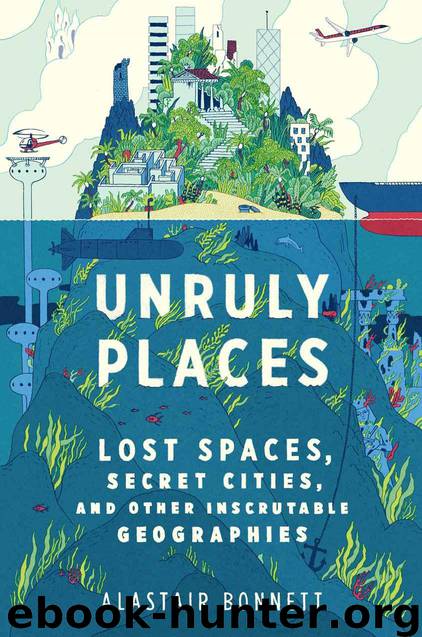Unruly Places: Lost Spaces, Secret Cities, and Other Inscrutable Geographies by Alastair Bonnett

Author:Alastair Bonnett
Language: eng
Format: azw3, epub, mobi
Publisher: Houghton Mifflin Harcourt
Published: 2014-07-08T00:00:00+00:00
Bright Light, 4 Mures Street, Bucharest
44° 28′ 04″ N, 26° 02′ 45″ E
Number 4 Mures Street is an off-white single-story office building with plenty of large windows. It’s a cheaply built, rather rundown 1960s construction and doesn’t appear especially secure. It is fronted by modest metal railings. Behind this block, which lies on a dusty residential street in northeast Bucharest, there is a larger building painted in the same municipal shade, and behind that, some train tracks. Number 4 Mures Street looks like a place where officialdom is slowly churning and employees watch the clock, waiting to go home.
Between the end of 2003 and May 2006, 4 Mures Street had the CIA code name Bright Light. It was a secret interrogation and detention center, a so-called black site, and acted as a link in an international chain of covert detention and staging points used in the war against terror. For those detained here and for the rest of the world Bright Light did not exist—it was a non-place. We can call such sites non-places for two reasons: because these are spaces no one notices, and because they complete the bewilderment of the inmate—even when the hood is removed and the landscape glimpsed, it means nothing, it could be anywhere. One person who has made this connection is Bruce O’Neill, an anthropologist at Stanford University who has taken a special interest in the geography of “extraordinary rendition.” In the journal Ethnography, he argues that secret detention facilities appear to “thrive in the non-places.” They can grow and breed in these empty zones because no one cares about them: they are “generic and highly functional spaces that we pass through without establishing significant social or historical relations with them.” It is places that “escape our serious attention or observation,” O’Neill concludes, that provide “the ideal infrastructural site for a new kind of camp.”
It is the forgettableness and unseen nature of 4 Mures Street, along with numerous windowless rooms elsewhere, that make it ideal for the covert extension of state power. The building, then as now, was owned by the Romanian National Registry for Classified Information. What a spokesman calls “media speculation that the building hosted a CIA prison” has been “categorically denied,” and Romania’s foreign affairs minister has confirmed that “no such activities took place on Romanian territory.”
But the German media, specifically the Süddeutsche Zeitung newspaper and the ARD television network, have done more than speculate. Their interviews with former inmates and CIA agents pinpoint Bright Light in great detail. Journalists have been able to build up a plan of the complex and uncover the names of those who were kept there and what happened to them. What they found out was that the back building has a basement with six specially designed cells, each one built on springs. The idea appears to have been that a permanent sense of imbalance would disorient inmates, though ironically the cells also had an arrow painted on the floor to indicate the direction of Mecca.
Bright
Download
Unruly Places: Lost Spaces, Secret Cities, and Other Inscrutable Geographies by Alastair Bonnett.epub
Unruly Places: Lost Spaces, Secret Cities, and Other Inscrutable Geographies by Alastair Bonnett.mobi
This site does not store any files on its server. We only index and link to content provided by other sites. Please contact the content providers to delete copyright contents if any and email us, we'll remove relevant links or contents immediately.
| Historic | Information Systems |
| Regional |
Man-made Catastrophes and Risk Information Concealment by Dmitry Chernov & Didier Sornette(4731)
The Revenge of Geography: What the Map Tells Us About Coming Conflicts and the Battle Against Fate by Kaplan Robert D(3596)
Zero Waste Home by Bea Johnson(3286)
COSMOS by Carl Sagan(2944)
In a Sunburned Country by Bill Bryson(2942)
Good by S. Walden(2910)
The Fate of Rome: Climate, Disease, and the End of an Empire (The Princeton History of the Ancient World) by Kyle Harper(2431)
Camino Island by John Grisham(2380)
A Wilder Time by William E. Glassley(2358)
Organic Mushroom Farming and Mycoremediation by Tradd Cotter(2304)
Human Dynamics Research in Smart and Connected Communities by Shih-Lung Shaw & Daniel Sui(2175)
The Ogre by Doug Scott(2105)
Energy Myths and Realities by Vaclav Smil(2054)
The Traveler's Gift by Andy Andrews(2008)
Inside the Middle East by Avi Melamed(1937)
Birds of New Guinea by Pratt Thane K.; Beehler Bruce M.; Anderton John C(1905)
Ultimate Navigation Manual by Lyle Brotherton(1764)
A History of Warfare by John Keegan(1712)
And the Band Played On by Randy Shilts(1612)
